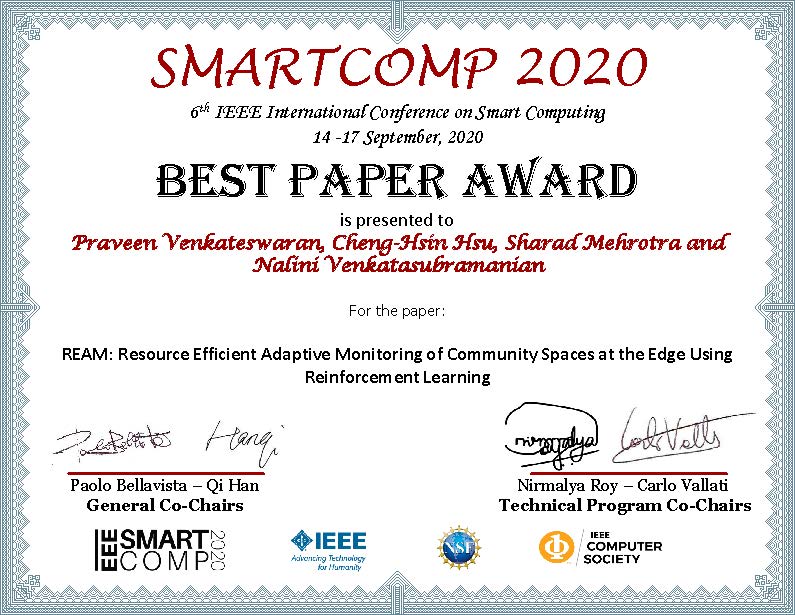Computer Science Researchers Win Best Paper Award for Work on Smart Community Monitoring
At the Sixth IEEE International Conference on Smart Computing (SMARTCOMP 2020), a trio of researchers from the Donald Bren School of Information and Computer Sciences (ICS) received the Best Paper Award. Ph.D. student Praveen Venkateswaran co-authored the work with Computer Science Professors Nalini Venkatasubramanian and Sharad Mehrotra, in collaboration with Associate Professor Cheng-Hsin Hsu of National Tsing Hua University, Taiwan. Their paper, “REAM: Resource Efficient Adaptive Monitoring of Community Spaces at the Edge Using Reinforcement Learning,” presents a framework for combining Internet of Things (IoT) technologies with machine learning techniques to better support smart infrastructure.

The work was motivated by the increasing use of IoT devices for monitoring in community spaces — for example, to check pollution levels, detect accidents, or assess the health of infrastructure systems such as power grids and water pipes. Despite the ever-increasing number of devices, there is no existing management platform in place. “Running all these devices continuously without a coherent management framework can lead to network congestion, wasted power consumption, as well as large amounts of redundant sensor data needing to be stored,” says Praveen, explaining the need for their resource efficient adaptive monitoring platform.
“REAM uses reinforcement learning to understand and learn the unique spatio-temporal patterns in each community space in order to continuously determine the best combination of sensors to activate at any given time,” he says. In this way, REAM ensures adequate monitoring levels and performance without overconsuming resources. “For instance, a pedestrian-monitoring application on campus could use cameras during the day when there is large footfall, but during the night could switch to a motion-sensor-based approach,” says Praveen. “However, different community spaces have various patterns, and learning them is a unique challenge that REAM addresses.”
Through an ongoing collaboration with the Orange County Public Works Department, the researchers have used REAM as part of the stormwater systems management initiative in Orange County. Currently, the quality of water in the storm drains is monitored using several battery-operated chemical sensing units installed underwater. “Since replacing the battery in these units involves a lot of effort in retrieving the unit, our goal was to use REAM to learn a subset of sensors that could be used at different times that could still provide a similar monitoring performance as if we used all the sensors, but could vastly prolong the battery life of these units,” explains Praveen. “We showed that the framework resulted in a months-long improvement in battery life, which could provide a lot of saved resources considering the numerous storm drains around Orange County.”
Praveen says he was “delighted” to learn of their Best Paper Award. “It has given us more motivation to continue with our work on smart community monitoring as well as the stormwater management initiative.”
— Shani Murray